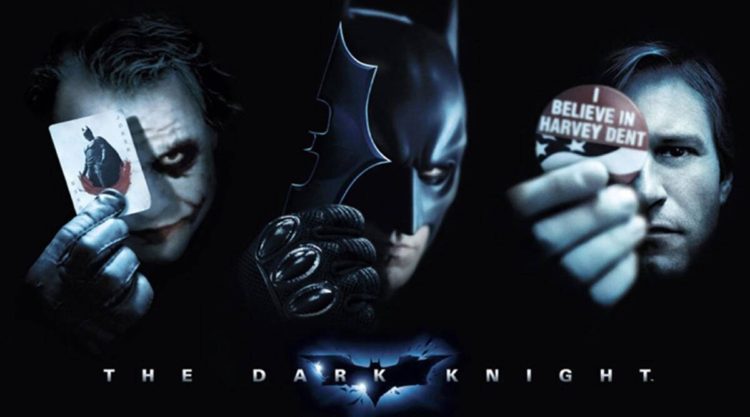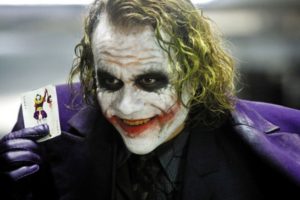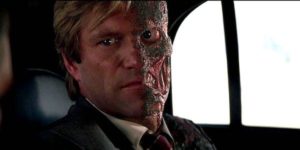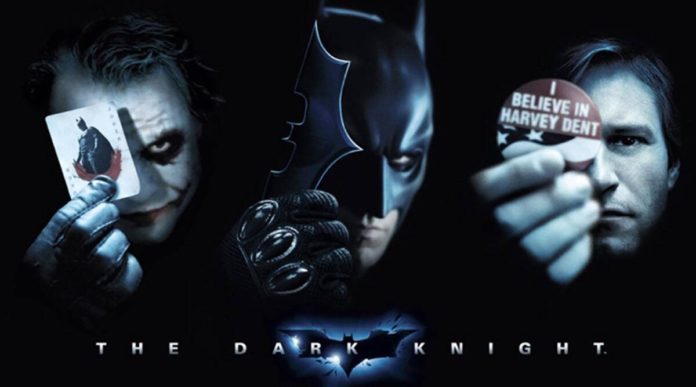
I’m just going to be honest: I love The Dark Knight. Love it. Every minute of it. It’s probably my favorite comic book movie, let alone my favorite Batman film, and this is coming from someone who is almost strictly Marvel. Even over a decade after its release, my brain will just flashback to scenes or shots of the film without warning or provocation, and you know what? I’m fine with that.
Where do I even begin talking about The Dark Knight? The movie starts with a carefully planned bank heist with gunmen wearing grotesque clown masks, and it just grabs you. As the robbery goes down, the thieves each kill each other one by one, until finally, only one remains. It’s our introduction to the main antagonist, the Joker, a criminal genius who is hell-bent on chaos. But the audience doesn’t know that yet. All we see is a ruthless, cunning bank robber. It’s a perfectly written scene, like something you’d expect to see in Michael Mann’s Heat as opposed to a superhero movie.
The next scene reintroduces us to Batman and what he’s wrought on Gotham City since Batman Begins. The police are torn between hunting him down to arrest him and trusting him, though the latter wins out through the leadership of Lieutenant Gordon. Meanwhile, in a secluded parking structure, a drug deal occurs between a Russian mobster and the Scarecrow. However, it’s interrupted by a group of Batman wannabes, showing the audience how Batman’s war on crime has inspired citizens to help clean up Gotham. However, when the real Batman shows up, he shows his disapproval of the vigilantism.

Eventually, the film shifts to Gotham’s District Attorney Harvey Dent. Mirroring Batman’s battle in the first film of the series, Dent is looking to prosecute a high-ranking mob boss. The similarities between Dent and Batman are more than implicit, the topic even being discussed in greater detail later on. By building up the integrity of a character like Dent, Nolan makes his fall from grace even more impactful.
Unlike Batman Begins, The Dark Knight is not about Batman. Not really, anyway. The film develops the character somewhat, within his personal life and the lengths he goes to eradicate crime in Gotham. But overall, it’s more about the antagonists. The Dark Knight features two of Batman’s most lethal villains who have tested Batman’s strength and humanity in the comic books for years. And thankfully, Christopher Nolan treats them both with respect in The Dark Knight, making them as integral to the evolution of Batman as they should be.

Heath Ledger takes on the role of the Joker. When the casting choice was first introduced, I was skeptical. At the time, the only movies I’d seen Ledger in were A Knight’s Tale and 10 Things I Hate About You. “There’s no way he can pull of the Joker,” I said to myself. And I will happily state that I, and thousands of others, was proven wrong.
Ledger took the role of the Joker to an entirely new level. As the third actor to portray the Joker on film (and no, I’m not counting Mark Hamill in that number), Ledger gave the character so much life. He takes the Joker to places that no other actor has taken him. The Joker of The Dark Knight is more than a painted-over mustache or Jack Nicholson in whiteface. And a large part of this is through Nolan’s masterful direction, such as not delving into the character’s past. The only backstory we get of the Joker is when he talks about how he got his scars, yet the story is different each time. The Joker lies; it’s what we expect him to do. He’s the embodiment of unpredictable, fueled by an incredible intellect. It’s what makes him “fun.”

But with how great Heath Ledger was as the Joker, Aaron Eckhart’s Harvey Dent deserves just as much praise. Eckhart plays Dent with grace, displaying his strength of character with finesse. Dent comes off as a cocky SOB, yet he’s hard not to like — which is a trait that should be displayed by an elected official, I suppose. But then comes his transformation into Two-Face.
After being disfigured by an explosion and having his girlfriend killed (who also happens to be Bruce Wayne’s love interest), Dent is no longer as resolute as he was. Earlier in the film, we see that he has grown tired of constantly fighting the evil of Gotham, winning small battles here and there but always seeing the bad guy come out on top. He comes close to his breaking point with only Batman being able to hold him back.
After losing the love of his life, and with some convincing from the Joker, Dent changes his ways. “Introduce a little anarchy,” the Joker tells him. But part of Dent remains. The part of him that feels the law should punish criminals. So he adopts the law as his scarred two-headed coin. Using the coin, Harvey’s Two-Face avenges Rachel by delivering justice to the people who contributed to her death, even though it’s a decision he never makes of his own accord.
But despite the two flamboyant criminals in Gotham, the movie’s narrative would crumble if not for the underlying evil it focuses on: organized crime. Batman waged war on the mob in Batman Begins, and that war continues through The Dark Knight. The Joker takes advantage of the mob to further his own goals while an errant mob accountant is the reason Dent, Gordon, and Batman form a circle of trust. The idea of organized crime becomes the backbone of the film and adds to the realism. Let’s face it, if The Dark Knight was a movie about a crazy guy in whiteface and an ex-lawyer with half his face burned off running around trying to kill a guy in latex, it would not have been nearly so well received. But thankfully Nolan takes a clever approach – one that works to his, and the movie’s, advantage.
The movie’s themes are also a part of what make it so good. Instead of a standard “Good guys fight bad guys”, The Dark Knight focuses its energies on actually having a purpose. The film delves into the idea of doing something for the greater good, which is echoed in many different ways. When Batman searches Gotham for the Joker, he builds a computer that eavesdrops on every electronic device in the city, an action that disgusts Lucius Fox. Batman is now privy to every conversation in the city. But Batman isn’t using this power to his advantage; he’s trying to stop a killer. Does his need to prevent the loss of life justify his spying on innocent civilians?
Another example is when Alfred burns the letter from Rachel, written to Bruce before her death, to prevent Bruce from learning that she plans on marrying Harvey. Bruce was under the impression that Rachel had chosen him, and her death cemented his need to be Batman and fight the evils of the city. Would the letter have changed Bruce’s decision to continue on as Batman? Maybe. Does Alfred have the right to keep that information from Bruce, even if it serves the greater good?
Whether for good or for bad, The Dark Knight changed the face of superhero movies. Christopher Nolan showed the world that, with the right vision and the right direction, films starring guys in tights can be just as good and just as complex as other movies. Even if you changed the main characters of the film and removed the comic book connection while keeping the plot of The Dark Knight, the characterization, and the subtle nuances sprinkled throughout the film, the movie would still be good.
The Dark Knight is a classic and one that does the source material justice.

